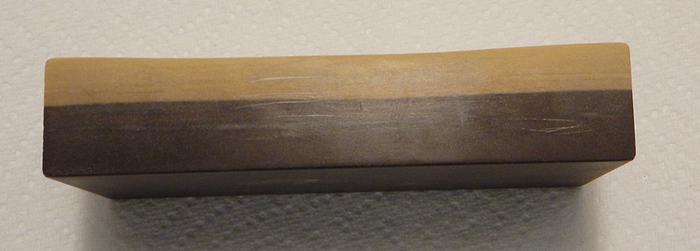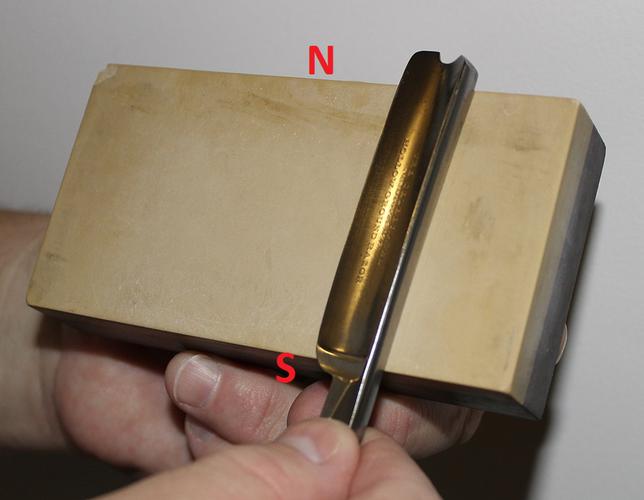Results 1 to 10 of 14
Thread: Coticule lapping
-
06-18-2016, 03:38 AM #1
 Coticule lapping
Coticule lapping
Today I brought out a few of my coticules. A small 100 x 30mm and a 200 x 75mm to be exact. Now both of these stones came to me "lapped". The smaller of the two was lapped by the guy who sold it to me. The larger lapped on the Belgians lapping table. Fresh out of the box... mmmm. I didn't lap these stones when I recieved them. Just started using them, they work fine.. excellent results have been obtained on both. This got me thinking I can't remember the last time I lapped any of my coticules.
When I first started I lapped my coticule every honing session.. absolute flatness or bust. I never truly understood how flat the slurry stone kept the base stones. Until I honed a few razors on a coticule and then did a pencil grid lap and it was 95% flat. More then flat enough to be of use. So since that day I have to say I am a lazy lapper. Rarely do and I find my results don't ever suffer as the result of a less then perfectly flat hone. I know there are other coticule guys who do this? Is this a coticule thing? Why do coticule guys think they don't need to lap there stone a lot to ensure near perfect flatness?
I wonder if users of other natural stones do this?
Just some of my thoughts on the issue.
-
06-18-2016, 03:52 AM #2

Here is the Coticule that my barber used for years to maintain his razors, before they required disposable blades. It is dipped & the one photo shows the method he used with shave cream. The hone is obviously "dipped" & only used in the middle.
I think that years ago, lapping was not a common practice.


-
The Following User Says Thank You to Hirlau For This Useful Post:
Disburden (06-18-2016)
-
06-18-2016, 03:55 AM #3Senior Member

- Join Date
- Jul 2015
- Posts
- 165
Thanked: 7
Makes no difference to me, but I use other hones in my progression, so I lap as a matter of habit.
-
06-18-2016, 03:59 AM #4Senior Member



- Join Date
- Apr 2012
- Location
- Diamond Bar, CA
- Posts
- 6,553
Thanked: 3215
Yup, as long as it’s smooth. You might get, a bit more performance from a dead flat stone, but you’ll also wash a lot of good stone down the drain…
-
06-18-2016, 05:51 AM #5< Banned User >


- Join Date
- Jul 2015
- Location
- Central Oregon
- Posts
- 789
Thanked: 98
Well, if ya do lap it, save the slurry dust for later crushed slurries. I rub my coticule on my 4000 to clean it, works good for me and keeps the stone flat as I need it to be.
-
06-18-2016, 07:19 AM #6Senior Member



- Join Date
- Dec 2014
- Location
- Virginia, USA
- Posts
- 2,224
Thanked: 481
I don't have a coticule, but I'll chime in since you asked about other naturals. This is about where I'm at with it. I probably don't have to tell you why I won't lap my Arkanstones - I'll probably never manage to run them slightly out of flat much less dish them visibly. And one round of that action is enough for a lifetime. My synthetics don't get lapped every single time I use them, and I've also got a PHIG and 3 Welsh slates. They've all been flattened (once), and because they're all stones that to my estimation see some benefit from a good polish, have all been polished on one side. The PHIG is burnished on top of that, and falls in teh same category as Arkanstones - I'll probably never dish it appreciably. Aside from some slurry stone action, this is about all the attention they've gotten, and hopefully judicious use of the slurry stone will keep the lapping plates at bay.
I know a coticule is a slightly different animal, and can vary from soft and lapping plate friendly to hard as that little slurry stone I traded out with you, and I imagine a full sized hone of that material would eat a lapping plate like a PHIG or Ark. Even if I ended up with a soft one, I don't think I would lap it too much. Like Euclid says, a lot of good stone going down the drain. Instead I would try to focus on using as much of the stone's surface as possible, try not to favor one side or the other too much, and give a little extra rubbing stone attention to the sides and ends where the razor isn't in contact as much. At the very least if one of my stones does dish like Hirlau's, I'd like to see it dished evenly across the stone, instead of on just the side I favored. Well, these are also stones that benefit from a polish, and the finishing side tends to get less use anyway. The side that I use for slurry work gets lapped more because I like a rough DMT 325 surface for that. Once the DMT scratches are worn away, I run the plate over the stone enough to put more back on. This is less about keeping the stone dead flat, and more about keeping the surface scuffed for expedited cutting.
Since my synthetics are the softest of the group, they're sort of my test bed for the method. So far the only one I have any inclination to lap is the 4K and that isn't because it's out of flat so much as because I suspect the pores have more swarf than most here would allow. I use this stone probably more than any other in my possession at the moment. Even with that it still cuts fast enough that I can use it to set a slightly off bevel, and flat enough to give a respectable edge. I think I'd rather get a Norton prep/slurry stone and clean it up a little so the experiment can continue.
-
06-18-2016, 12:05 PM #7

Let's discuss this. I really want to understand and I need to know your thoughts on why performance would be a little better if a coti was dead flat.
I've been of the thought train that as long as you perform a perfect x stroke minor variation in the hones surface is inconsequential. Due to this I have been practicing performing perfect x strokes. I used to do a more windshield washer type stroke but have found results are a little better for me doing the x. Now you've got me thinking that the windshield washer type stroke wasn't working as well for me due to the hone being dished (if only ever so slightly) to the point where results started slipping. I wasn't making even contact throughout thr stroke. More of an issue with the honer for not recognizing and not the hones fault. Likewise if a straight down and back stroke was utilized I can see that becoming an issue also.
This also brings up another issue I have been pondering. Say for example I have a razor that I need to set a bevel on. I do this on a freshly lapped 1k king for arguments sake. I proceed to do a dilution method as usual in my house. Going from a bevel being set on a flat hone to an unlapped coticule makes me think.. dead flat to relatively flat. The edge would have to be brought to a point where it is making even contact with the stone, in this case the coticule. Keeping the spine flat on hone would also cause the edge would ride over the uneven geometry of the hones surface. The honer would need to use the correct stroke ultimately to deal with this. Making refinement maybe a little more challenging due to first having to get the whole edge into contact with the hone. (depending how poorly it's out of flat, this may not be an issue).
Refinement may be a little quicker if you went from flat 1k to flat coticule (relatively flat). I think dishing would eventually cause the bevel to become more rounded. Is convex the word I am looking for?
Thanks Euclid in advance.
ScottLast edited by s0litarys0ldier; 06-18-2016 at 12:18 PM.
-
06-18-2016, 12:31 PM #8

I use my coticule mostly for touch ups. Once every couple of months. It would take a looooong time for me to dish mine.
-
06-18-2016, 02:17 PM #9Senior Member



- Join Date
- Apr 2012
- Location
- Diamond Bar, CA
- Posts
- 6,553
Thanked: 3215
Scott,
Well, a perfectly flat stone will have more surface contact.
On a stone not perfectly flat, the razor will ride on the high spots. But really the difference in performance would be, almost un-noticeable and on an expensive or quality stone you have to weigh, how much you will waste, over a possible slight, improvement in performance.
I think it is impossible to use all of a stone evenly, and you will always have more wear in the middle, and less on the ends and corners, or you run the risk of running off the stone.
I know a lot of Old School, Japanese honers just hone, (circles and half laps) on the high spots of a stone, (ends and corners) to flatten it out and not waste, any of the stone, lapping it.
Most of the used coticules I have bought are a bit dished, they are soft. Yes, they will convex a blade, but the convexing is only the width of the blade, which will not be very much, (maybe a thousandth or two, in a ½ to ¾ of an inch) not the shape of the stone, (1/4 to ½ in dish, over the length of the stone). That is the portion of the blade, (from spine to edge) in contact at any one time a very, very small amount.
Personally I believe convexing is a good thing, making a stronger edge with more steel behind it, Apple seed vs Arrow shaped.
I don’t think going from a flat stone to a not perfectly flat stone is an issue worth worrying about, firstly as the stone is only perfectly flat when you start honing and Kings are soft, er. After a few laps it is no longer perfectly flat, same with the coticule, after a few laps the razor conforms with the shape of the stone. And really all we care about is the edge, not the shape of flatness of the bevel.
I guess if you were after near perfection, a micro bevel would make sense, then it becomes less of an issue.
But then you strop it and it all goes out the window...
-
The Following User Says Thank You to Euclid440 For This Useful Post:
aalbina (07-19-2016)
-
06-18-2016, 03:13 PM #10

Thank you for taking the time to explain it in such depth. Cleared up some questions I have had as of late.


 24Likes
24Likes LinkBack URL
LinkBack URL About LinkBacks
About LinkBacks






 Reply With Quote
Reply With Quote

